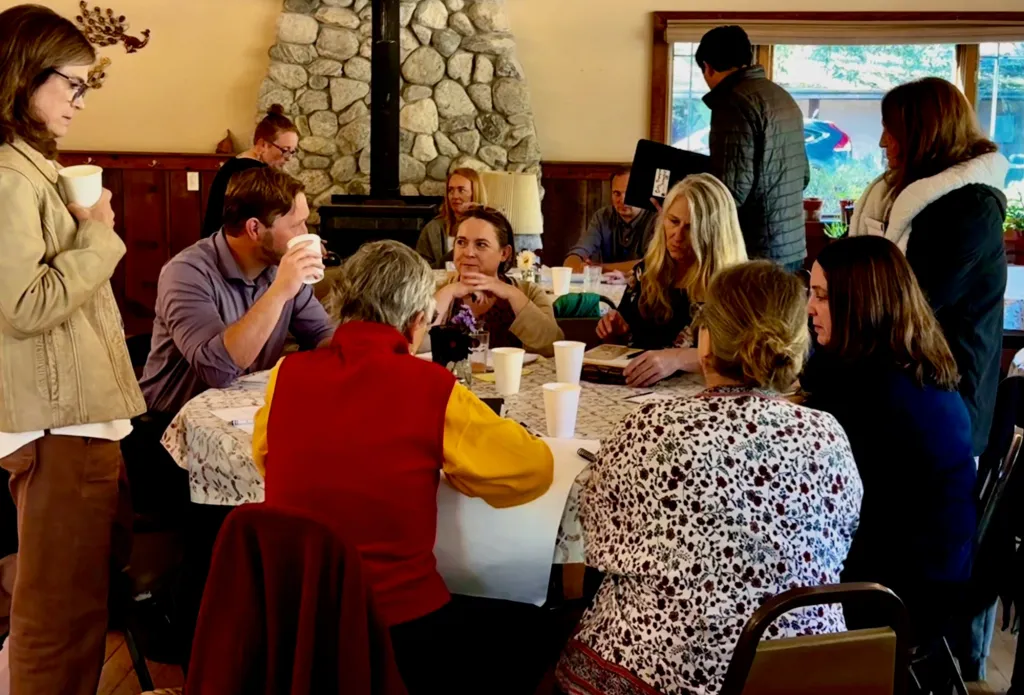Copyright Santa Rosa Press Democrat

A quadruple-whammy of a health care crisis is about to hit Mendocino County hard. A group of about 20 individuals from a wide sector of health care-adjacent agencies and organizations serving Mendocino County met Thursday to discuss how to help patients and how medical staff can best prepare for and weather the coming changes. The meeting was organized by Incubate: a 3-year-old, countywide collaboration originally convened to help recruit and retain medical providers. Incubate’s first official event took place in 2023, when the need for a collaborative effort to recruit and retain providers in Mendocino County was identified. According to Governor Gavin Newsom’s office, Californians will see an average monthly share of their Covered California health insurance premiums increase from 73% to 388% starting in January, 2026, due to the HR1- dubbed President Trump’s “Big Beautiful Bill.” Newsom’s office estimates that nearly 2 million Californians currently receiving Covered California will be financially decimated by the health care bill hikes- and estimates that hundreds of thousands of other individuals will lose coverage altogether. It is anticipated that low-income residents will be hit hardest- meaning those who earn less than $62,600 monthly. Premiums for that group, according to Newsom’s office will rise from $97 to $182 per month. Older Californians ages 55-64 will see increases from $186-$365 monthly, and approximately 500,000 self-employed Californians will face a $131 per-month increase. Communities of color will see rises of over 100%, and middle-class families- an estimated 160,000 in the state will lose their health insurance tax credits of about $500 monthly. Additionally, according to Cal Matters, Gov. Newsom has proposed freezing Medi-Cal enrollment to low-income immigrants without legal status, a move expected to save the state more than $5 billion. Under this proposal, in 2026, Medi-Cal would no longer accept new enrollees 19 years of age and under who lack permanent legal status. The 1.6 million immigrants already signed up would not lose coverage, and children could still enroll. Emergency medical services and pregnancy care would still be available, but for those who don’t enroll prior to January, 2026, they would be ineligible for basic medical expenses like prescriptions and doctor’s visits. At the meeting Thursday , Incubate member Jeremy Malin, FNP, and director of community health analytics for Adventist Health Ukiah, acknowledged that today’s event represents the organization’s pivot to a different, very pressing issue. “Stakeholder organizations and other health care organizations are, at this juncture concerned about the loss of eligibility around health insurance and what those community impacts will be,” he told the attendees. “We’re hoping to set up a framework to support primary health care organizations and the individuals providing care.” Other Incubate members in attendance included Daphne McNeil, who was involved in earlier efforts to launch a family residency project in Ukiah, and is interested in supporting collaborative efforts to address the loss of health insurance. Incubate member Miranda Ramos represents a network of 5 qualifying centers such as the Mendocino Community Health Clinics Anderson Valley Health Center, and is also a member of Nuestra Alianza in Willits. Denae Brunner’s husband is a 3rd-year resident at Adventist Health Ukiah (AHU). She is using her expertise in social work to assist with the collaborative process. Co-facilitator for the day was Lindsay Hunt, a consultant who has worked with Incubate on past projects, and focuses on the creation of systems and structures to facilitate change. Representatives from the several agencies within the County of Mendocino, Long Valley Health Center, Redwood Community Services, US Representative Jared Huffman’s Office, the Family Medicine Residency Program, Anderson Valley Health Center, Ford Street Project, Adventist Health, Alliance for Rural Community Health/Community Health Resource Network, Mendocino Community Health Centers, First 5, Partnership Health Plan of California and Healthy Mendocino gathered for a day of discussion and brainstorming. The event’s guest speaker was Maria Lewis. As well as living in Puerto Rico and working in under-resourced areas in the US, Lewis is a Harvard-trained expert in health reform and social entrepreneurship. Her research in in Puerto Rico had particular relevancy to the current US health care crisis. According to Lewis, 1 million Puerto Ricans will go without health services this year- literally 1/3 of the island’s population, compounded by a severe shortage of health professionals. Surprisingly, though the US territory has the highest incidence of chronic diseases, their life average expectancy is 3.5 years higher than people living in the United States. Half the population lives under the poverty level, and 80% of the territory’s healthcare budget is allocated to the prevention of chronic disease,. Lewis notes that according to a multi-year Harvard-based adult health study, the top health predictor of similar-aged people — half who were Harvard graduates and the remaining who were belonged to a lower social/economic bracket — was not how many visits to the doctor they had, but the quality of their relationships. Lewis’s work in Puerto Rico verifies this theory. “Puerto Rico is the No. 4 country with the most centenarians per capita. These people don’t live in affluent areas. They are mountain people, who walk, eat healthier and live in community,” she explains. An actuarial formula created by the University of Connecticut is the tool insurance companies use to determine the cost of premiums. Lewis explained that those facts uphold the significance of lifestyle changes in dramatically altering the number of years an elder person lives with disabilities and the number of years people stay alive. Lewis developed a State Innovation Plan for Puerto Rico, concluding that no changes in the overall health of the territory can truly improve until decision makers embrace what optimum health looks like in their own lives. “Most of us in health care focus on reducing disease. Real health is not the absence of disease, it is the capacity to thrive and live fully.” In contrast to a wellness approach, she notes how the industry spends trillions on building “sick care systems,” as opposed to focusing on wellness. Through her work as a board member with the American College of Lifestyle Medicine, Lewis is advancing evidence-based lifestyle medicine to treat, reverse and prevent chronic disease. “The evidence on lifestyle changes is so overwhelming. The Center for Medicaid Services has created a code to recognize Type 2 Diabetes in remission,” she emphasizes.” This type of thinking requires mindset changes by both providers and the community.” Many lessons were learned by Puerto Ricans following the devastating 2017 hurricane, when the island existed for six months with no power, a single company providing patchy cell phone coverage, sparse food and no gas. “A crisis exposes systemic fragility. We discovered that people are our real infrastructure.” No GIS locators existed to find health care services on the island. “So people who knew the island boarded helicopters and pointed out the locations. When systems break, the relationships in these rooms make change happen.” She stressed the importance of caring for health workers during crisis times. “Showers, food, gas and water were provided to employees by their employers.” Collaboration, Lewis emphasizes, is the antidote to chaos. “The future of health must be people-centered. Technology must be in service of humanity, and health care must occur beyond hospital walls,” she concluded. Though the upcoming health care crisis might not compare to a Level Five Hurricane, the need for preparation and a catalyzation between stakeholders is critical- especially when there are still many unknowns in terms of exactly when changes will occur and specifically who will be impacted. A document outlining the impacts of the pending changes and possible mitigations was passed out, focusing primarily on the most critical issues coming up in the next year. In January 2026, Medi-Cal will consider assets when reviewing eligibility for older adults and people with disabilities as part of the application/renewal process, with an asset limit of $130,000 for one person. And in January 2026, Medi-Cal will freeze new enrollments for certain adults who are undocumented immigrants. This group will no longer be able to newly enroll in full-scope Medi-Cal. Those enrolled prior to 1/1/2026 will be able to remain enrolled, as long as they continue to be eligible. Also, in July, 2026, dental coverage will no longer be a Medi-Cal benefit for UIS immigrants over the age of 19. In July 2026, there will be a one-year ban on federal Medicaid (Medi-Cal in California) for what the Trump administration identifies as “prohibited entities” that provide abortion services. And if the current government shutdown continues into 2026, it remains unclear how Medi-Cal services will be funded. This is only a portion of the massive changes to Medi-Cal come next year. Those who are recipients of Partnership Health program will be subject to different changes. The group broke out into smaller teams to begin the process of identifying key areas to address, as the calendar moves the country inexorably toward massive changes to the health care delivery system. Three issues were addressed- the need for innovation, messaging and ways to care for an already-taxed healthcare workforce. A number of suggestions were given and catalogued by the Incubate team, who will take the next steps of scheduling future meetings, identifying likely agencies to take on specific tasks and inviting additional stakeholders to the table. Some of the recommendations included training helpers to assist undocumented people with eligibility enrollment procedures, working with school districts to pass on important health care information to families, supplying information to church and community groups and providing on-site basic testing and screening at vineyards and other locations. The need for broad community message utilizing media, broadcast in multiple languages was discussed, as well as encouraging health care delivery organizations to build in policies to promote retention and reduce burnout, as well as considering the creation of a countywide form to help people identify and document work requirements. As this was the first of what will undoubtedly be many more meetings, it is anticipated that more stakeholders will be invited to attend, such as law enforcement, emergency service providers, representatives from the school systems, probation, childcare providers, senior support agencies and more. It remains unclear how much of the proposed federal $50 billion for rural health care will trickle into Mendocino County. It is also unclear if cuts to SSDI are on the table. Both documented and undocumented immigrants will be impacted by both federal and state changes to health care access. It is important to understand that people are in a variety of stages in the process of becoming citizens- and it appears that federal cuts will affect them as well. Fear of deportation increases if people fear their citizenship status might be required by health care agencies to receive care. But the other side of the issue is the brushfire that could occur if an uninsured, undocumented family has a child with measles and chooses out of fear to avoid seeking treatment. The group discussed the importance of making sure that undocumented people who currently receive benefits stay enrolled. Adventist Health, as part of their mission is committed to providing care to anyone, regardless of documentation status. Jacque Williams, executive director of the Ford Street Project and the Ukiah Community Food Bank emphasized the importance of standing behind the undocumented workers who form the backbone of many industries in Mendocino County. “The impact of all of this is that lots of people who will qualify for coverage will choose not to access coverage. Even though ICE hasn’t been in our county yet, the chilling effect is here. These people are an important, integral part of our economy. We can all see the farms, restaurants, hotels, orchards and vineyards, and understand their significance.” Nightmare insurance stories are starting to trickle in. On Rep. Huffman’s website, “Corrie” says, “My husband and I are retired public school teachers. We were only able to retire because of Covered California subsidies. Now our monthly premiums will increase from $447 to $3,685.” “Sophia,” a single mom and a brain aneurysm survivor says, “Right before the Christmas holiday, our payments are going to go from $180/month to nearly $700.” And “Jessica” says, “$468 to $2,600 per month is more than a 5x increase! I don’t know how we’re going to deal with that expense.”



